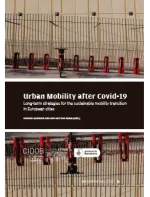How can shared mobility contribute to the post-pandemic urban mobility transition?

The severe economic impacts of the COVID-19 pandemic and the social distancing measures introduced to tackle it have caused the mass adoption of telecommuting. The result was an unprecedented reduction of mobility and temporary improvements in air quality in major urban areas. But the pandemic also widened the mobility divide between social groups. Disadvantaged neighbourhoods and low-income communities where people are more reliant on public transport and often have low-skilled jobs that are not compatible with remote work have been severely impacted and faced major travel disruptions. With lockdowns, people were forced to meet their needs in their neighbourhoods, highlighting differences in quality of life between high and low amenity areas. One of the few positive aspects of this development was the forced reduction of travel distances, which triggered a burst in the use of active and shared mobility that is better suited to such shorter trip ranges. The post-pandemic normality is expected to present serious challenges to the urban mobility transition. In this chapter, I explore the likely mid- to longterm effects on the mobility sector and why shared mobility might be key to achieving a positive outcome.